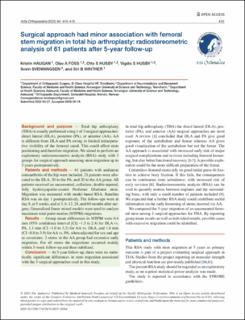| dc.contributor.author | Haugan, Kristin | |
| dc.contributor.author | Foss, Olav A. | |
| dc.contributor.author | Husby, Otto Schnell | |
| dc.contributor.author | Husby, Vigdis Kvitland Schnell | |
| dc.contributor.author | Svenningsen, Svein | |
| dc.contributor.author | Winther, Siri Bjørgen | |
| dc.date.accessioned | 2023-11-07T13:59:03Z | |
| dc.date.available | 2023-11-07T13:59:03Z | |
| dc.date.created | 2023-09-04T09:23:09Z | |
| dc.date.issued | 2023 | |
| dc.identifier.citation | Acta Orthopaedica. 2023, 94 410-415. | en_US |
| dc.identifier.issn | 1745-3674 | |
| dc.identifier.uri | https://hdl.handle.net/11250/3101162 | |
| dc.description.abstract | Background and purpose: Total hip arthroplasty (THA) is usually performed using 1 of 3 surgical approaches: direct lateral (DLA), posterior (PA), or anterior (AA). AA is different from DLA and PA owing to limited intraoperative visibility of the femoral canal. This could affect stem positioning and therefore migration. We aimed to perform an exploratory radiostereometric analysis (RSA) study with 3 groups for surgical approach assessing stem migration up to 5 years postoperatively.
Patients and methods: 61 patients with unilateral osteoarthritis of the hip were included. 21 patients were allocated to the DLA, 20 to the PA, and 20 to the AA group. All patients received an uncemented, collarless, double-tapered, fully hydroxyapatite-coated Profemur Gladiator stem. Migration was measured with model-based RSA. Baseline RSA was on day 1 postoperatively. The follow-ups were at day 8, at 5 weeks, and at 3, 6, 12, 24, and 60 months after surgery. Generalized linear mixed models were used to analyze maximum total point motion (MTPM) migrations.
Results: Group mean differences in MTPM were 0.4 mm (95% confidence interval [CI] –1.5 to 2.4) for DLA vs. PA, 1.1 mm (CI –1.0 to 3.3) for AA vs. DLA, and 1.6 mm (CI –0.8 to 3.9) for AA vs. PA, when adjusted for sex and age as covariates. 2 stems in the AA group had excessive early migration. For all stems the migrations occurred mainly within 5-week follow-up and then stabilized.
Conclusion: At 5-year follow-up, there were no statistically significant differences in stem migration associated with the 3 surgical approaches used in this study. | en_US |
| dc.language.iso | eng | en_US |
| dc.publisher | Medical Journals Sweden AB | en_US |
| dc.rights | Navngivelse-Ikkekommersiell 4.0 Internasjonal | * |
| dc.rights.uri | http://creativecommons.org/licenses/by-nc/4.0/deed.no | * |
| dc.title | Surgical approach had minor association with femoral stem migration in total hip arthroplasty: radiostereometric analysis of 61 patients after 5-year follow-up | en_US |
| dc.title.alternative | Surgical approach had minor association with femoral stem migration in total hip arthroplasty: radiostereometric analysis of 61 patients after 5-year follow-up | en_US |
| dc.type | Peer reviewed | en_US |
| dc.type | Journal article | en_US |
| dc.description.version | publishedVersion | en_US |
| dc.source.pagenumber | 410-415 | en_US |
| dc.source.volume | 94 | en_US |
| dc.source.journal | Acta Orthopaedica | en_US |
| dc.identifier.doi | 10.2340/17453674.2023.18264 | |
| dc.identifier.cristin | 2171927 | |
| cristin.ispublished | true | |
| cristin.fulltext | original | |
| cristin.qualitycode | 1 | |

